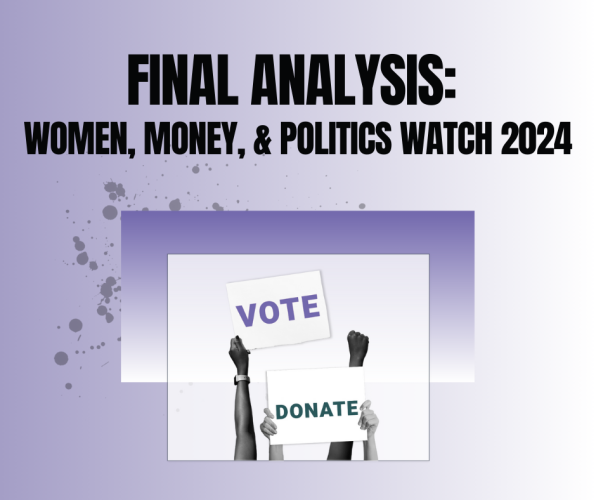Are Resources the Answer? How gender, race/ethnicity, and financial resources shape political giving.

We recently published our Final Analysis: Women, Money, & Politics Watch 2024 report, concluding CAWP’s research on fundraising and donating for the 2024 election cycle. One of the key findings from CAWP’s 2024 Women, Money, & Politics Watch project is that women from historically underrepresented racial/ethnic groups are especially underrepresented as campaign contributors to congressional elections.
We found that Black women constituted 1% of all money contributed to 2024 congressional candidates. Likewise, Asian American women’s contributions only constituted 1% of all money contributed; and Latinas contributed just 1% of all money contributed. Our analysis was based on donations made during calendar year 2024 to all major party congressional candidates in the running as of July 15, 2024 using data from OpenSecrets and Catalist.
These donation disparities are related to the underrepresentation of Black women, Latinas, and Asian American women in elective office, since we find gender and race/ethnic affinity effects in giving patterns to candidates.
One might assume that women of color are underrepresented as donors because of income and wealth inequalities. But in a new analysis about the giving patterns of Asian American women and Latinas, I find that financial resources provide only a partial explanation.
I analyzed how financial resources affect political giving for Asian American women and Latinas. These two panethnic groups are fast-growing populations who are more likely to be foreign-born than other racial/ethnic groups. Data for my study came from the landmark 2020 Collaborative Multiracial Politics Survey (CMPS).
In a multivariate statistical analysis, I found that factors such as income and homeownership play a limited role in explaining the political contributions of Asian American women and Latinas. In fact, only income mattered to political giving, and for Latinas only.
In contrast, for both Asian American women and Latinas, I found that charitable giving was more likely to be a function of economic factors, including income, than political giving. And, notably, both groups of women were more likely to report giving to charities than to politics. Among Asian American women, 12% gave to candidates or campaigns in my analysis of the 2020 CMPS data compared with 39% who gave to charities; for Latinas, 12% gave politically and 29% charitably.
Combined with CAWP’s research on donor demographics, I offer several implications for political practitioners including activists and candidates.
First, more women from historically underrepresented groups can give–even with current economic inequalities. Asian American women and Latinas who are motivated to give to charities could be encouraged to give to political candidates that align with their values.
Second, and particularly for Latinas compared with Asian American women, resource limitations are real. Improving economic opportunities for women—and particularly women with lower assets and incomes—could make it easier to wield political voice via campaign contributions.
Third, candidates and fundraisers may be foregoing dollars if they aren’t seeking donations from Asian American women and Latinas. Women’s charitable giving rates indicate that more political giving is possible.
Donor gaps are partially a challenge of social norms, as I argued in a recent study. Because campaign donations are a form of political voice, political giving is a valuable component of democracy.


